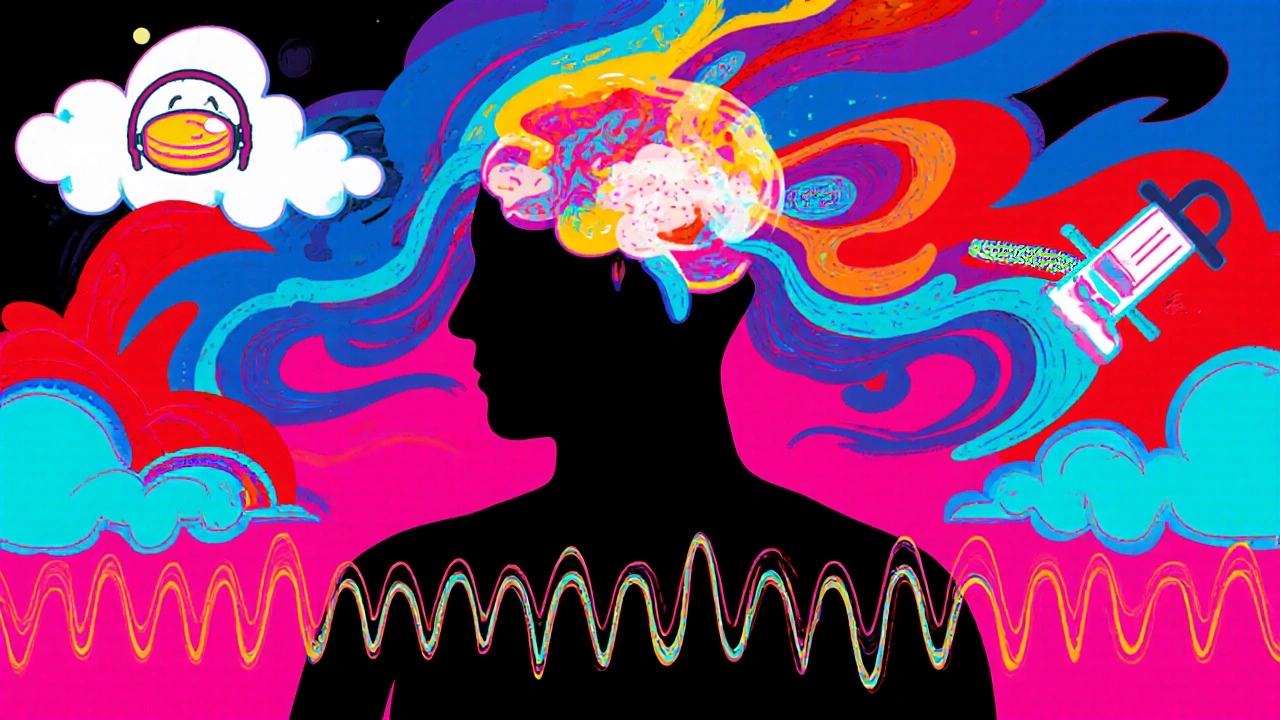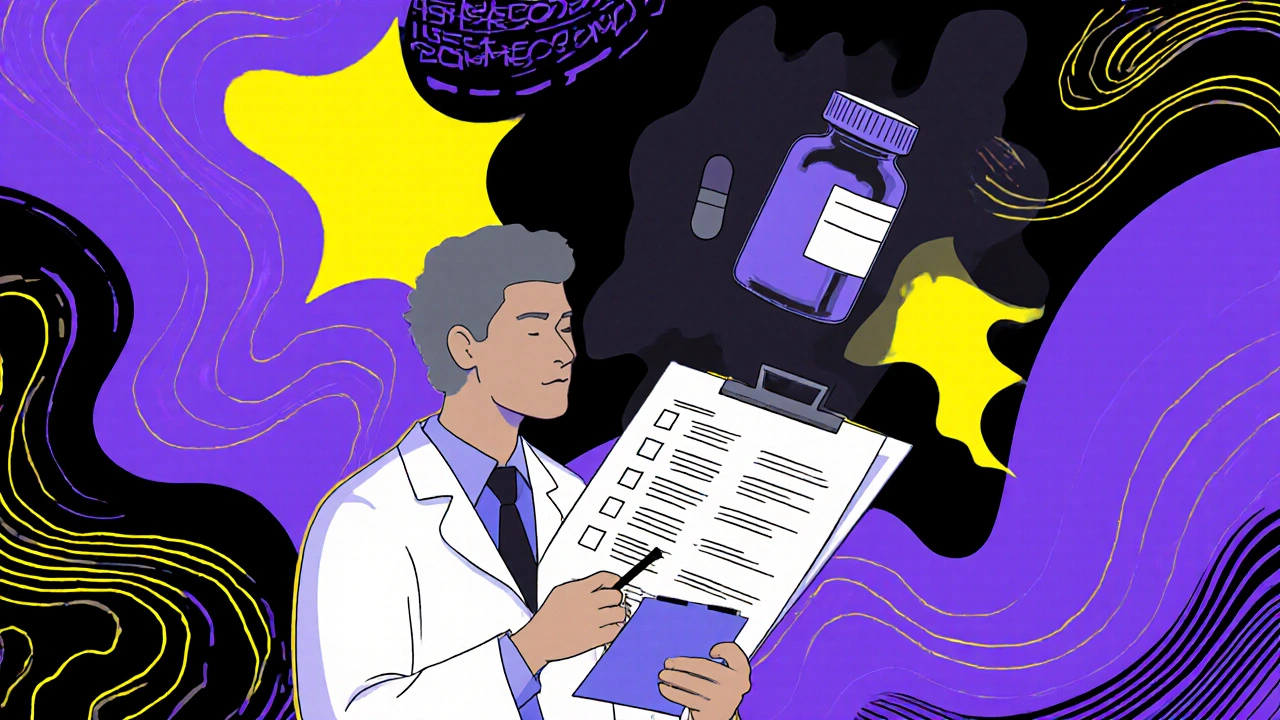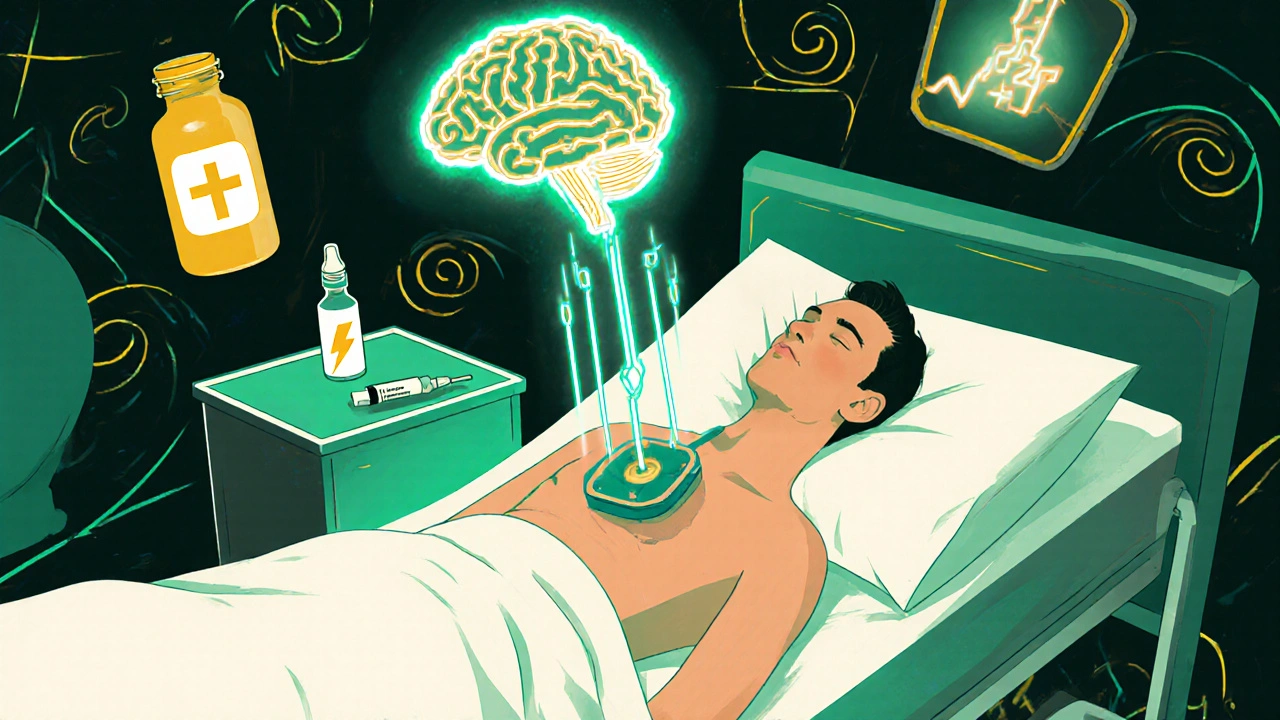
Benzodiazepine-Opioid Respiratory Risk Calculator
How this works
This calculator estimates the combined respiratory depression risk when benzodiazepines and opioids are taken together. It uses data from clinical studies showing the supra-additive effect of this combination. The risk calculation factors in both drugs' individual depression effects plus their synergistic interaction.
When Benzodiazepines are a class of sedative‑hypnotic drugs that enhance GABA‑A receptor activity, commonly prescribed for anxiety and insomnia are taken together with Opioids are potent analgesics that act on mu‑opioid receptors (MOR) in the brainstem to reduce pain and suppress breathing, the result is a dangerous combined respiratory depression that can quickly become fatal.
How Opioids Alone Impair Breathing
Opioids depress the respiratory drive primarily by activating MORs in two key brainstem regions. In the preBötzinger Complex (preBötC), which generates the rhythmic inspiratory signal, opioids cause hyperpolarization of neurons, slowing the inhale rhythm. In the Kölliker‑Fuse/Parabrachial (KF/PB) complex, they increase tonic expiratory drive, prolonging exhalation and promoting apnea. Studies by Montandon et al. (2011, 2016) showed that blocking MORs in the KF/PB partially restores normal breathing, highlighting the dual‑site mechanism of opioid‑induced respiratory depression (OIRD).
How Benzodiazepines Affect the Respiratory Network
Benzodiazepines boost inhibitory GABA‑A signaling throughout the central nervous system. While therapeutic doses usually cause only mild respiratory slowing, they potentiate inhibition in the same brainstem nuclei targeted by opioids. The result is an amplified suppression of both inspiratory and expiratory phases, especially in the post‑inspiratory window where the respiratory rhythm is most vulnerable.
Synergy: Why the Combination Is More Than Additive
Sun et al. (2018) demonstrated that fentanyl plus midazolam reduced minute ventilation by 78 %, compared with 45 % for fentanyl alone and 28 % for midazolam alone. The synergy stems from two complementary pathways:
- Opioids blunt the drive to breathe by MOR activation in preBötC and KF/PB.
- Benzodiazepines amplify GABA‑mediated inhibition across the same networks, deepening the dip in respiratory output.
This dual‑pathway assault accounts for the supra‑additive effect seen in animal models and human overdose data.
Epidemiology: How Common Is the Problem?
National surveillance paints a stark picture:
- In 2019, the CDC recorded that 16 % of opioid overdose deaths involved benzodiazepines.
- Prescription‑opioid overdoses had benzodiazepines present in 17.0 % of cases; illicit‑opioid overdoses in 22.5 %.
- From 2010 to 2021, opioid‑related deaths rose from 21,089 to 80,411, with 75‑80 % involving multiple drugs (NIDA, 2022).
- Patients prescribed both drugs face a ten‑fold higher risk of fatal overdose compared with opioids alone (Dowell et al., 2016).
These numbers underscore why the combination is a top priority for clinicians and policymakers.

Clinical Guidelines and Prescribing Safeguards
The CDC’s 2016 guideline for chronic pain strongly recommends avoiding concurrent prescriptions unless absolutely necessary. When co‑prescribing is unavoidable, the recommendation includes:
- Use the lowest effective doses of each drug.
- Limit treatment duration-ideally under 30 days for benzodiazepines.
- Implement rigorous monitoring: urine drug screens, frequent follow‑ups, and use of Prescription Drug Monitoring Programs (PDMPs).
- Educate patients on overdose signs and equip them with naloxone kits.
The FDA’s 2016 black‑box warning and the REMS program for extended‑release opioids reinforce these precautions. A 2022 analysis showed a 14.5 % national drop in concurrent prescribing after the warning, yet 8.7 % of long‑term opioid patients still received benzodiazepines.
Emergency Management: Reversal Strategies
Naloxone remains the gold standard for reversing opioid‑mediated respiratory depression, but it does nothing for the benzodiazepine component. Emerging research points to adjunctive agents:
- Flumazenil can antagonize benzodiazepine effects but carries seizure risk, especially in chronic users.
- Animal studies (Ren et al., 2022) found the ampakine CX1739 restored normal breathing in fentanyl‑alprazolam combos, hinting at future pharmacologic solutions.
- Mechanical ventilation and high‑flow nasal cannula provide supportive breathing while pharmacologic reversal takes effect.
Until a bifunctional reversal agent is approved, clinicians must anticipate the need for both opioid and benzodiazepine antagonists during overdose resuscitation.
Public Health Initiatives Targeting the Duo
Multiple policies aim to curb the deadly pairing:
| Policy | Year Enacted | Primary Action |
|---|---|---|
| FDA Black‑Box Warning | 2016 | Mandated label warnings; required REMS education on concurrent use |
| SIGNAL PDMP Alerts | 2017‑2020 | Automatic alerts to prescribers when both drugs are ordered |
| SUPPORT for Patients & Communities Act | 2018 | Required Medicare Part D drug‑utilization reviews for high‑risk combos |
| CDC Enhanced Opioid Overdose Surveillance | 2017 | Tracks benzodiazepine involvement in opioid overdoses |
These measures have modestly reduced co‑prescribing rates, yet the fatality trend remains high, with an estimated 12,000‑15,000 combined overdose deaths projected through 2025.

Future Directions: Research and Technology
Funding from the NIH HEAL Initiative ($15.7 M in FY2022) supports studies on dual‑depressant respiratory mechanisms. Promising avenues include:
- Development of bifunctional antagonists that bind both MOR and GABA‑A sites.
- AI‑driven PDMP algorithms that flag high‑risk dose combinations in real time.
- Implantable “breathing pacemakers” that detect apnea and deliver brief electrical stimulation to the preBötC.
While these innovations are in early stages, they reflect a growing commitment to outpace the lethal synergy of benzodiazepines and opioids.
Practical Checklist for Clinicians
- Screen every patient for current benzodiazepine use before initiating opioid therapy.
- If co‑prescribing is unavoidable, limit benzodiazepine to ≤2 weeks and use the lowest effective opioid dose.
- Enroll the patient in the state PDMP and set up automatic alert rules.
- Provide a naloxone rescue kit and train the patient/family on its use.
- Schedule follow‑up within one week to reassess pain control, anxiety, and any signs of sedation.
Bottom Line
The combination of benzodiazepines and opioids creates a perfect storm for respiratory failure. Understanding the dual‑pathway mechanism, recognizing the epidemiologic burden, and applying strict prescribing safeguards can save lives. When an overdose occurs, remember that naloxone alone may not be enough-be prepared to address the benzodiazepine side of the equation as well.
Why does combining benzodiazepines with opioids increase overdose risk?
Both drug classes depress breathing, but they act on different receptors-opioids on mu‑opioid receptors and benzodiazepines on GABA‑A receptors. Together they produce a supra‑additive effect that suppresses both inspiratory and expiratory drive, making fatal respiratory depression far more likely.
Can naloxone reverse a benzodiazepine‑opioid overdose?
Naloxone quickly reverses the opioid component by displacing opioids from MORs, but it does nothing for the benzodiazepine‑induced inhibition. In severe cases, additional support such as flumazenil (with caution) or mechanical ventilation may be required.
What prescribing safeguards should I follow?
Screen for existing benzodiazepine use, use the lowest effective doses, limit treatment duration, enroll patients in PDMP alerts, and provide naloxone kits with education.
Are there any emerging drugs that can reverse both depressants?
Research on compounds like the ampakine CX1739 shows promise in animal models, but no FDA‑approved bifunctional antidote exists yet.
How prevalent is co‑prescribing in the U.S.?
CDC data indicate that about 17 % of opioid‑related overdose deaths in 2020 involved benzodiazepines, with the highest rates among adults aged 45‑64.
15 Comments
Robert Gilmore October 25, 2025 AT 18:44
The synergistic depressant effect of concurrent benzodiazepine‑opioid therapy is mediated by overlapping GABA‑A and mu‑opioid receptor pathways, amplifying neuronal hyperpolarization across the preBötC and KF/PB networks, resulting in profound hypoventilation.
Robert Gilmore October 26, 2025 AT 15:57
I’ve seen patients in the ER where naloxone alone doesn’t reverse the sedation because the benzodiazepine component persists, so it’s crucial to have flumazenil on hand when safe, and always educate families about dual‑overdose signs.
Robert Gilmore October 27, 2025 AT 14:10
Honestly, the reality is that many prescribers still bundle these meds, and the data-like the 16 % co‑involvement figure-just proves the point, so we need tighter PDMP alerts, better patient counseling, and, of course, broader access to rescue kits!
Robert Gilmore October 28, 2025 AT 12:24
A quick screen for benzodiazepine use before starting opioids can catch most risky combos. It’s simple and saves lives.
Robert Gilmore October 29, 2025 AT 10:37
Let’s light a fire under the system! Every prescription pair is a potential ticking time‑bomb, and we deserve bold policies that slam the brakes on this deadly duet.
Robert Gilmore October 30, 2025 AT 08:50
Doctors keep ignoring the warning signs, prescribing without checking the med list, and then act surprised when patients crash. It’s a stupid cycle that needs to end now.
Robert Gilmore October 31, 2025 AT 07:04
Check PDMP, limit benzo to 2‑weeks, and always co‑prescribe naloxone; that simple checklist cuts risk dramatically.
Robert Gilmore November 1, 2025 AT 05:17
The convergence of GABAergic potentiation and mu‑opioid receptor agonism represents a paradigmatic example of pharmacodynamic synergy that transcends simple additive toxicity. When a patient ingests fentanyl in conjunction with midazolam, the preBötC respiratory pacemaker is subjected to simultaneous hyperpolarizing currents that collapse inspiratory drive. Simultaneously, the KF/PB expiratory nucleus receives amplified inhibitory signals that protract exhalation and precipitate apnea. This dual assault on both phases of the respiratory cycle creates a physiologic milieu where carbon dioxide retention escalates unchecked. Clinicians often underestimate the magnitude of this effect because the individual dose‑response curves appear modest. However, animal models have consistently demonstrated a 78 % reduction in minute ventilation under combined exposure. Human post‑mortem data corroborate these findings, showing a disproportionate rise in fatal outcomes when the two drug classes co‑occur. The underlying neurobiology involves convergent intracellular signaling cascades that potentiate potassium conductance and suppress excitatory neurotransmission. Moreover, chronic tolerance to opioids does not mitigate the benzodiazepine‑induced GABA potentiation, leaving the respiratory network vulnerable. From a public health perspective, the 16 % co‑involvement statistic is not a mere footnote but a clarion call for systemic reform. Regulatory bodies have responded with black‑box warnings, yet prescribing inertia persists. Healthcare systems must integrate real‑time decision support that flags high‑risk combinations at the point of care. Education of prescribers should emphasize the limited therapeutic window of benzodiazepines when used alongside opioids. Patients should be equipped with dual‑action rescue kits and taught to recognize early hypoventilation cues. Future pharmacotherapy may yield bifunctional antagonists that simultaneously displace opioids and reverse GABAergic inhibition. Until such agents become available, the safest strategy remains rigorous risk assessment, dose minimization, and vigilant monitoring.
Robert Gilmore November 2, 2025 AT 03:30
Some claim the pharma lobby hides the true danger of combos to keep profit margins high and the public stays in the dark about the real scale of the crisis. The data are there but filtered through biased reports.
Robert Gilmore November 3, 2025 AT 01:44
Remember, a proactive approach combining patient education, naloxone distribution 😊, and careful titration can dramatically lower mortality rates, and it’s something every clinician can implement today.
Robert Gilmore November 3, 2025 AT 23:57
Oh great, another reminder that mixing depressants is a bad idea-who would have thought?
Robert Gilmore November 4, 2025 AT 22:10
Spoiler: the combo still kills.
Robert Gilmore November 5, 2025 AT 20:24
Wake up, America! Your love affair with pills is a cultural disaster and it’s time to break the habit before the next wave of dead bodies floods the morgues.
Robert Gilmore November 6, 2025 AT 18:37
I can hear the cries of the silent lungs, each gasp a shattered hope, and the nightmare of overdose painting the night with blood‑red terror.
Robert Gilmore November 7, 2025 AT 16:50
While the drama is intense, the solution is simple: stick to guidelines, avoid unnecessary combos, and keep the community safe.